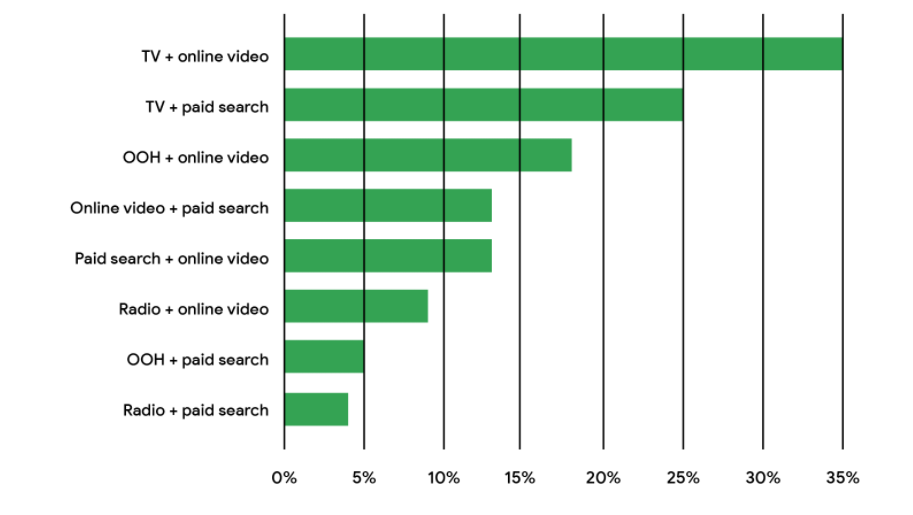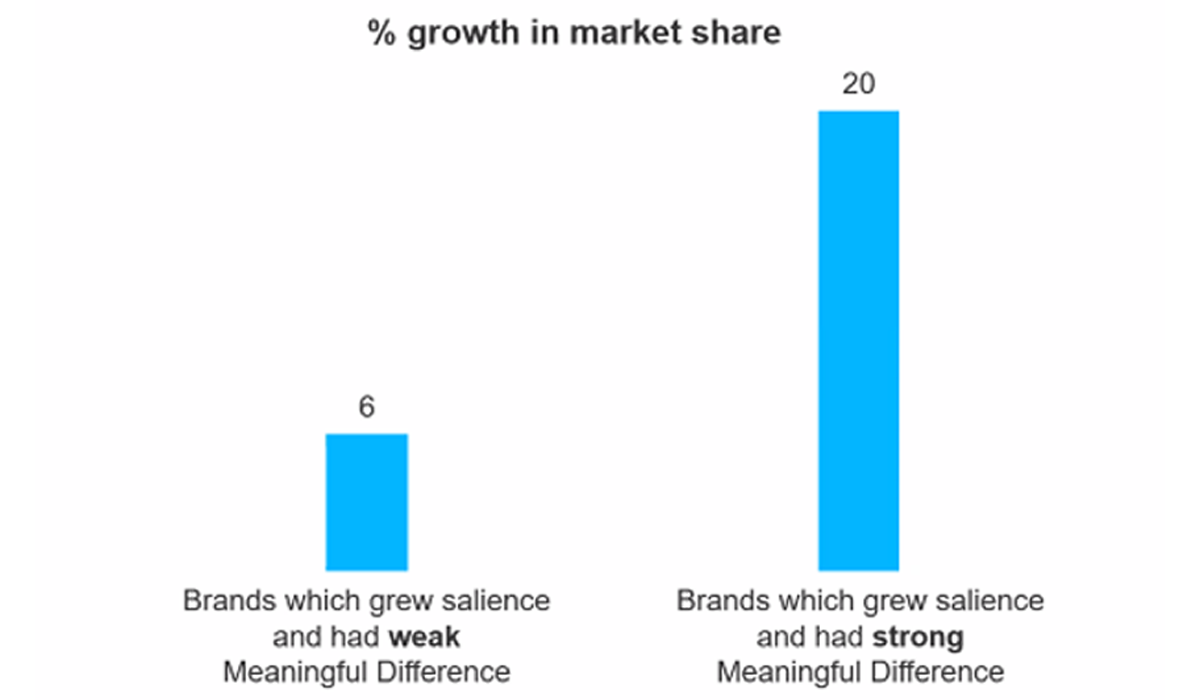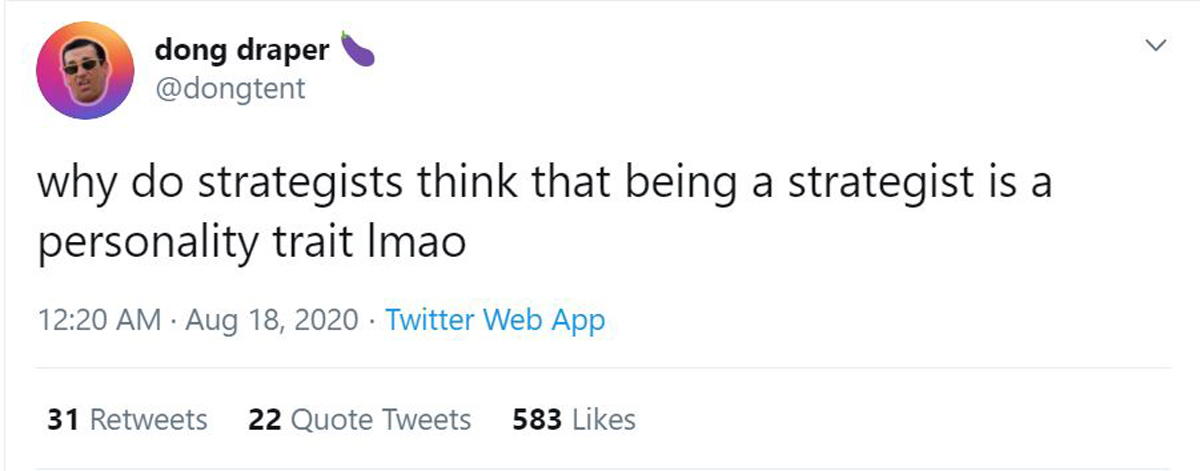Marketing theory is a constant battle between opposing viewpoints, but an open mind and accurate data set will show you usually need to adopt both perspectives.
Last month, the marketing copywriter Dong Draper (not, I assume, his real name) posted on Twitter. “Why,” he asked his followers, “do strategists think that being a strategist is a personality trait? LMAO.”
His question proved popular. Within a few hours ‘Dong’ had amassed more than 500 likes and several pointed responses. One of them came from Michael Kates who works in – you guessed it – strategy for McCann in Toronto. “Why do creatives think they’re the only ones who get to have ideas?” he asked his followers rhetorically.
On 18 August, in a little corner of Twitter, we had the perfect encapsulation for marketing and how we practise it. At some point in the new century we stopped reading marketing textbooks and started beating the shit out of each other on social media over our contrasting professional perspectives.
You’ll note in this instance, and in most others, both perspectives might be in direct opposition to each other but still make equally valid points. Creativity is a key aspect for marketing success and great creatives are worth their weight in gold. But the idea that the best ideas always come from two people chained to a desk until midnight versus everyone else in the organisation – and, for that matter, the millions that make up the market – is highly improbable.
And it’s a similar story for strategy. It has been enjoying a renaissance in recent years. But there has also been a giant increase in the number of people who claim to be a strategist with a capital S and who generally overcomplicate things with pompous discussions about Derrida and ‘survivorship bias’, neither of which they fully understand.
So, rather than look for the better point, it is always superior to surmise that both claims, together, make most sense. And, indeed, even a rudimentary knowledge of marketing (from those text books that we no longer read) would tell us that strategy should be combined with creativity for optimum effect. Marketers even have a process for this combination, centering on the creative brief, to ensure that the two are thoroughly intertwined for maximal impact.
From now on, when presented with any marketing concept as superior to another, don’t reject that argument but try to add the alternative view as well.
The realisation that two counter-arguments in marketing are not only both correct but also more powerful considered together did not come from Michael and Dong’s twitter tennis. I’d been pondering this idea for several days already after reading a splendid Tom Roach essay, ‘The Wrong and the Short of It’.
Roach’s central argument is that we have held Field and Binet up as the defenders of long-term brand building when, in fact, their work is as much about doing the short as it is about the long. Roach goes on to argue that “the organisational silos we inhabit, the different job titles we have, the different channels and formats we tend to use and the different metrics we try to optimise” all get in the way of being truly able to take both a long and short approach to marketing.
Seeing an alternative perspective
He’s right, of course. We see the world one way and attempt to denigrate any alternative perspective because our field of vision has already been established. And that act of denigration can help promote the original thought and bolster the certainty of those doing the thinking.
I re-posted Roach’s original essay on LinkedIn, asking other marketers to read it because it was so good. And one notable marketer – David Thomas – pointed out that he expected this essay and my subsequent promotion of it would “become known as the development of the Bothism model”.
I really liked that thought. And when The Marketing Society asked me to deliver the 2020 Ogilvy Lecture a few weeks later I stole it. And then stole even more by basing the thinking behind my subsequent talk on the fabulous work of Jim Collins.
The wrong and the real of marketing effectiveness
He wrote Built to Last – a smashing airport book about the successful habits of companies that are genuinely visionary. Collins notes at the start of his book that a key aspect of these companies is that they do not oppress themselves with the ‘tyranny of the or’, which he defines as “the rational view that cannot easily accept paradox, that cannot live with two seemingly contradictory forces or ideas at the same time”. This view pushes people “to believe that things must be either A or B, but not both”.
I loved this thinking, and its corollary that successful firms usually demonstrate the ‘genius of the and’, which enables them to embrace contrasting viewpoints as simultaneously true. That insight inspired me to define Marketing Bothism as “the rare capacity to not only see the value of both sides of the marketing story, but actively consider and then co-opt them into any subsequent marketing endeavour in an appropriate mix”.
If you know anything about marketing you will know that there is an enormous need for Bothism in our discipline right now. We are riven by so many contradictory and combative points of view, most of which would prove more powerful if wrangled into combination rather than opposition. The long brand-building approach versus the short performance marketing route is merely one of many central dichotomies bedevilling marketing at the moment.
The need for Bothism
There is TOFU and BOFU (top of funnel and bottom of funnel), which obscure the power of stepping back and seeing the whole funnel, and using that complete, connected view to inform strategy.
There is the ancient debate about qualitative versus quantitative research methods. That debate divided academic marketing in the late 20th century into two tribal factions and still causes angst. This is despite the fact that the simple answer to that tyrannical question of method is to start with qual to elicit the correct variables inductively and then plug them into a suitable quant tool to measure magnitudes, causality and implications. One without the other is weak.
We’ve had the decade-long custard-pie fight over ‘digital’ versus ‘traditional’ forms of communication. I remain completely bemused as to what these terms actually mean in 2020, given almost every form of communication from radio to outdoor is now demonstratively digital in delivery. And yet we have spent all this time pushing the benefits of one side and then defending the honour of the other.
Twenty minutes with a decent data set and an open mind would demonstrate to any marketer that when you adopt a Bothist view of communications and add a dash of traditional media to the digital cake mix, the whole confection improves dramatically as a result. Something Analytic Partners and Ebiquity keep doing, to almost every marketer’s total intransigence. So much for ‘evidence-based’.

There is the continued debate about targeting too. Marketers are paralysed between the probity of taking a targeted approach and their equal empirical certainty that they should do the opposite and adopt sophisticated mass-marketing. The power of a two-speed brand plan is partly to be found in the realisation that, when you are building long-term brand campaigns, it does indeed pay to go for mass marketing and aim at everyone in the category. But, once we get to the bottom of the funnel and performance marketing, you really do want to shift to targeted, product-based campaigns instead. Bothism exemplified.
We need a new ‘third way’ to set marketing budgets
And how about the ongoing tension between differentiation and distinctiveness? For 30 years we were told to “differentiate or die” – a perfect exemplar of the opposite of Bothism. Then along came Ehrenberg-Bass in their black uniforms and we were thrashed into accepting differentiation as wildly overstated and distinctiveness as the ultimate goal for brands.
That hegemony is so strong at the moment that to even suggest that some brands might be perceived differently from others is to elicit cat calls and “rhubarb-rhubarbs” from most conference audiences. This despite the fact that it is patently true, and that Kantar have been politely proving the combination of salience and meaningful difference is greater than the sum of those two parts for years.

A marketing Bothist would immediately…




